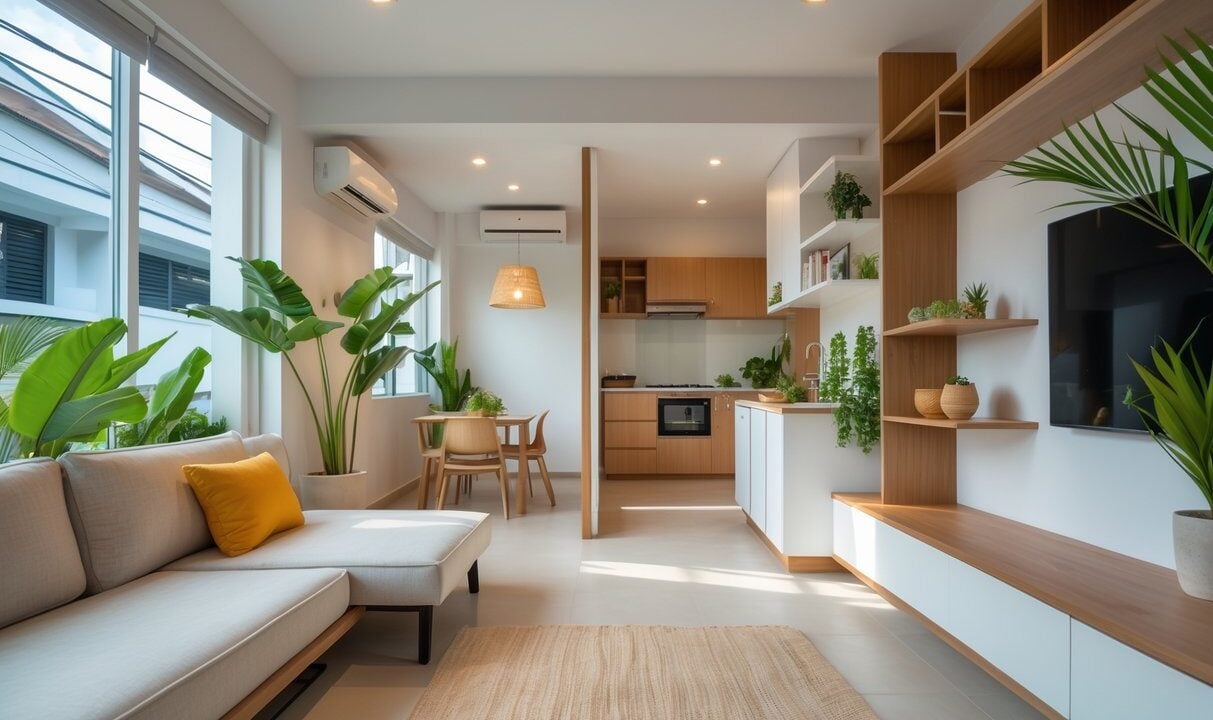Maximizing Space in Cebu Townhouses: Expert Design Tips & Guide
Living in a Cebu townhouse comes with its fair share of perks—and, yeah, a few headaches—especially when you’re trying to squeeze comfort and style out of a pretty tight space. Maximizing space with some clever design moves—think multipurpose furniture, stacking storage up high, and letting in as much daylight as possible—can make even a small home feel like a cozy, inviting hideaway. With Cebu’s urban boom, planning your interiors well isn’t just about convenience; it can also make your place stand out if you ever decide to sell or rent.
Folks all over Cebu, from Lahug to Mandaue, can really benefit by opening up their floor plans, adding built-in storage, and mixing in modern touches that nod to local style. The right tweaks help create spaces that breathe, flex, and actually feel good to live in—whether you’re hosting friends or just unwinding after work. Want to get the most out of your own townhouse? There are plenty of practical tips ahead to help you make it happen.
Key Takeaways
- Smart layouts and furniture choices make Cebu townhouses easier to live in.
- Good storage and more daylight mean greater comfort and function.
- Thoughtful design keeps your home stylish and ready for whatever comes next.
Understanding the Challenges of Space in Cebu Townhouses
Townhouses in Cebu usually don’t have a lot of room to spare—blame the city’s crowded landscape and rising property prices. The trick isn’t just about fitting things in, but also making sure you’re maximizing space works for your family’s daily routines and Cebuano traditions.
Urban Living and Small Footprints
Most Cebu townhouses are on narrow lots, making every inch count. Rooms end up small, and if you get any outdoor space, it’s probably just a balcony, maybe a tiny patio.
Living in the city puts you close to everything, but you’ve got to be smart with your layout to avoid feeling boxed in. In places like Lahug or Mandaue, designs often go up, not out—extra floors are more common than big yards.
Townhouse design trends:
- Multi-level layouts
- Shared or semi-private outdoor spots
- Minimal space between house and street
Small footprints call for creative fixes—built-in cabinets, movable walls—anything to stretch out those square meters.
Importance of Efficient Townhouse Design
Good design isn’t just about cramming in more stuff. It’s about making your daily life smoother and your home feel bigger than it really is. When you plan things out, there’s less wasted space and more room for what matters.
These days, Cebu townhouses often go for open layouts, blending kitchen, dining, and living areas to make everything feel roomier.
Table: Common Space-Saving Features
| Feature | Function |
|---|---|
| Built-in Shelving | Keeps bulky furniture out of the way |
| Sliding doors | Saves space that swinging doors eat up |
| Lofted sleeping areas | Gives you extra usable floor space |
Balancing looks and practicality, a well-designed townhouse just feels better to live in—especially in the city.
Local Lifestyle Influences on Interior Design
The Cebuano lifestyle definitely leaves its mark on townhouse interiors. Family get-togethers, parties, and the need for a work-from-home spot are all pretty normal.
Designers often plan for rooms that can change roles fast—a guest room might double as an office, or the dining space needs to handle a crowd during the holidays.
People here love bright spaces and good airflow, so you’ll see bigger windows and more open layouts.
Adaptable interiors and local touches—like bamboo accents or Cebu-made woven decor—bring in tradition while still keeping things practical and organized.
Key design elements inspired by Cebuano living:
- Rooms that serve more than one purpose
- Furniture you can move or adjust
- Focus on fresh air and daylight
Optimizing Layouts and Multi-Functional Spaces

Making a Cebu townhouse feel bigger is all about smart design. You want maximizing spaces that flow, furniture that works overtime, and layouts that fit your daily routine—even in a small footprint. With some planning, you can have a home that’s stylish, comfy, and efficient all at once.
Open-Plan Living Strategies
If you can ditch a few walls, do it. Combining the kitchen, dining, and living areas into one big space lets in more light and air, and honestly, just feels less cramped. It’s also great for keeping an eye on the kids or chatting with friends while you cook.
Using the same flooring or wall color throughout pulls everything together. Arrange furniture to suggest “zones”—like a sofa to mark the living area or a table to separate the kitchen—but keep it open so nothing feels boxed in.
Key benefits
- Brings in more daylight
- Lets air flow freely
- Makes hosting easier
Flexible Room Configurations
Flexibility is a lifesaver when space is tight. Go for furniture you can move around or stack—nesting tables, folding chairs, stuff like that. Wall beds, extendable tables, or rolling carts are also super handy for quick changes.
Sliding or pocket doors open or close off rooms without eating up floor space. Modular sofas or screens can help you switch things up, whether you’re having guests over or just need a quiet corner to work.
Practical solutions:
- Modular couches
- Fold-down beds
- Movable dividers
Being able to change things up quickly is especially useful if your household is busy or your needs keep shifting.
Zoning for Work, Play, and Relaxation
Even in an open layout, you can carve out “zones” for different activities. Rugs, lighting, and shelves are easy ways to do it. Maybe a rug anchors the living area, and a pendant lamp marks your workspace.
Shelves or bookcases can act as partial dividers without closing off the room. Some people like to use color or accent walls to set apart a work nook or play space while still keeping things cohesive.
How to create zones:
- Lay down area rugs or use screens
- Add task lighting
- Place open shelves where you want a subtle divider
Zoning helps keep things organized and makes family life run a little smoother, which is always a win.
Smart Furniture and Storage Solutions
The right furniture and storage can make a Cebu townhouse feel way bigger and more useful. Picking pieces that do double duty keeps clutter down and helps every corner work harder for you.
Embracing Multi-Functional Furniture
Multi-use furniture is basically a must-have. Sofa beds are great—they give you a spot to lounge by day and turn into a guest bed at night. Storage ottomans hide extra bedding or shoes while doubling as a seat or footrest.
Fold-away desks and wall tables are perfect for rooms that need to work as both office and dining space. Just tuck them away when you’re done and you’ve got your floor back.
Coffee tables with drawers or shelves are good for stashing remotes and magazines. Beds with storage underneath keep clothes or linens out of sight but close at hand.
Why multi-functional pieces rock:
- Open up floor space
- Make rooms more adaptable
- Hide clutter easily
Innovative Built-In Storage
Built-ins are a game changer. Under-stair drawers or cupboards make use of awkward spots for shoes, cleaning stuff, or books. Custom cabinets in narrow halls or under windows are perfect for stashing seasonal clothes or pantry items.
Go for floor-to-ceiling cabinets in kitchens and bedrooms to use every bit of space. Sliding shelves help you reach stuff in deep cabinets. Open shelves above doorways are handy for baskets, bags, or a few nice-looking things.
These built-ins keep things tidy and easy to grab, so you don’t need as much bulky furniture cluttering up the place.
Built-in storage ideas:
- Drawers under the stairs
- Window seat storage
- Overhead cabinets
Maximizing Vertical Space
Don’t forget to look up—vertical storage is key. Wall shelves give you a place to show off or stash stuff without taking up floor space. Floating shelves in kitchens and baths keep essentials organized and handy.
Tall wardrobes or closets that go all the way up are great for clothes and bags. Hooks and pegboards on empty walls hold hats, bags, or kitchen tools.
If you need a workspace, try a wall-mounted fold-down desk or drop-leaf table. That way, you can fold it away when you’re done and free up the area.
Go vertical with:
- Bookcases that reach the ceiling
- Floating shelves
- Wall-mounted fold-away tables
Maximizing Natural Light, Ventilation, and Energy Efficiency
Design choices that let in more daylight, boost airflow, and keep energy bills down can make Cebu townhouses a lot more pleasant (and affordable). Simple fixes like bigger windows, better ventilation, and efficient appliances let you enjoy every square foot without giving up style.
Using Large Windows and Mirrors
Big windows bring in tons of light, making rooms look and feel bigger. In Cebu’s climate, they also let in breezes to help cool things off naturally. Higher windows—like clerestory ones—can add light while keeping your privacy intact.
Mirrors bounce sunlight around, brightening up even the gloomiest corners. Try hanging a mirror across from a window to spread the light. Glass doors or partitions also help keep things open and airy.
A bay window with built-in seating can double as a sunny reading spot or breakfast nook—nice, right?
Quick Tips:
- Pick slim window frames for more glass and less bulk.
- Skip heavy curtains; use sheer panels or blinds instead.
- Hang mirrors near windows to make the most of natural light.
Optimizing Natural Ventilation
Airflow really matters in Cebu’s warm, humid weather. If you put windows on opposite walls, you’ll get a cross-breeze that moves fresh air through the house and helps push out heat. Louvered windows, transoms, and vent blocks can keep air moving even when you need to close up for security.
Solar chimneys or exhaust fans pull hot air out from upper floors, so you don’t have to rely on air conditioning as much. Floor and ceiling fans keep air moving, which is especially helpful in open-plan homes.
Ventilation Features:
- Large windows you can open on more than one side
- Louvered doors or vent blocks inside
- Wide overhangs so you can leave windows open even when it’s raining
Good ventilation lowers humidity and helps keep mold and stale air at bay, making the place feel fresher.
Choosing Energy-Efficient Appliances
In smaller Cebu townhouses, appliances—especially fridges and cooling units—tend to work overtime. It’s smart to pick energy-efficient appliances with Inverter or Energy Star labels. These use less power and keep things cool without running up the electric bill.
LED bulbs are a no-brainer—they use way less energy and don’t add heat. Try to get fans and air conditioners with timers or energy-saving settings, so you’re not cooling empty rooms.
Appliance Tips Table:
| Appliance | Energy-Saving Feature | Cebu Relevance |
|---|---|---|
| Refrigerator | Inverter compressor | Runs quieter, saves power |
| Air Conditioner | High EER, Inverter technology | Lowers cooling costs |
| LED Bulbs | Low wattage, high brightness | Fits any fixture, stays cool |
| Fans | Brushless motor, timer settings | Good for humid climates |
Switching to efficient models pays off in the long run and helps keep small, sunny homes cooler day to day.
Designing with Local, Natural, and Sustainable Materials
The right materials can make Cebu townhouses more comfortable, healthier, and better for the environment. Using local, natural, or recycled stuff can also help cut costs and shrink your carbon footprint.
Incorporating Natural Materials
Natural materials like bamboo, rattan, coconut lumber, and local stone are everywhere in Cebu for a reason—they look good, last long, and help with ventilation. Bamboo panels or ceilings give a breezy, tropical vibe and keep rooms cool. Rattan furniture is light and fits tiny spaces well.
Locally sourced wood warms up living rooms, floors, or stairs. Stone tiles from Cebu quarries are great for feature walls or paths outside. Choosing natural materials supports local makers and helps your home blend into the surroundings.
Tip:
- Try woven bamboo blinds for privacy and soft light.
- Locally made cement tiles work for floors or kitchen backsplashes.
Utilizing Recycled Materials
Recycled materials cut down on waste and make your home greener. Salvaged wood from old houses can be turned into shelves, doors, or beams. Recycled glass tiles brighten up kitchens or bathrooms and bounce light around.
Upcycling old pallets or metal frames into cabinets or storage is easy on the wallet and gives rooms a bit of personality. There’s a growing community in Cebu selling furniture and decor made from reused materials, so finding eco-friendly options isn’t too hard.
Key ideas for using recycled materials:
- Turn glass bottles into pendant lights.
- Use reclaimed wood for accent walls or stairs.
- Pick up recycled metal planters for balcony gardens.
Implementing Sustainable Practices
How you build matters too. Go for low-VOC paints and finishes to keep the air healthier inside. Rainwater harvesting systems can supply water for the garden or laundry, so you use less from the tap.
Design for cross-ventilation with well-placed windows and vents, so you don’t need AC as much. Insulation made from recycled or plant-based fibers helps keep things cool or warm, depending on the season.
Whenever possible, buy from suppliers who get their materials locally in Cebu or the Visayas. You’ll cut down on transport emissions and support local businesses. Using native plants in the garden means less watering and less hassle.
Smart Home Technology for Townhouse Efficiency
Smart home tech is making it easier for Cebu townhouse residents to save energy, simplify routines, and boost security. Even simple gadgets can make life more comfortable and modern.
Integrating Automated Lighting and Climate Control
Automated lighting—think smart LED bulbs or motion sensors—only turn on when you need them. That means lower bills and a better vibe at different times of the day. Scheduling lights with sunrise or sunset is a nice touch, too.
Smart thermostats or Wi-Fi AC units let you control the temperature from your phone, even when you’re out. You can tweak settings before you get home, so it’s comfy when you walk in. Some models even learn your habits and adjust cooling automatically.
Adding a voice assistant like Google Assistant or Alexa to the mix makes it all hands-free. You can set “movie night” or “work mode” with a quick command, which is honestly pretty convenient for busy days.
| Smart Feature | Benefit | Example Device |
|---|---|---|
| Smart Bulbs | Energy savings | Philips Hue, Xiaomi Yeelight |
| Smart Thermostat | Temperature control | Nest, Ecobee, Daikin Smart AC |
Enhancing Security and Convenience
Modern security tech keeps townhouses safe without taking up extra space. Smart cameras let you check live video, get motion alerts, or see at night—all from your phone. You can keep an eye on things from work or even while traveling.
Smart locks use PIN codes, fingerprints, or your phone for entry. No more lost keys, and it’s easy to let in family or guests. Some locks even notify you when someone comes in, which is reassuring.
AI-powered alarms can spot break-ins, smoke, or gas leaks and send instant alerts to your phone. Brands like Ring, Yale, and August have options that work well in Cebu. These tools make safety management a lot less stressful, whether you’re home or away.
Frequently Asked Questions
Smart furniture picks, built-in storage, and clever design tricks can make small Cebu townhouses feel open and practical. Playing with color, mirrors, and outdoor space helps stretch usable areas without breaking the bank.
How can multi-functional furniture improve living space in a Cebu townhouse?
Multi-functional furniture pulls double (or triple) duty, which is a lifesaver when maximizing space is tight. A sofa bed gives you seating by day and a bed at night. Storage ottomans or folding tables help with daily routines and keep clutter down.
Furniture with hidden storage or pieces that tuck away offer flexibility. This is especially useful in living and dining spaces where activities change throughout the day.
What are some effective built-in storage solutions for small townhouses?
Built-in storage takes advantage of spots people usually forget, like under stairs or above doors. Pull-out drawers, hidden cabinets, and tall shelving can boost storage without cramping the room.
Custom cabinets fit narrow hallways or awkward corners, making use of every bit of space. Wall-mounted shelves keep stuff off the floor and open up more room to move around.
Can you explain the benefits of an open-plan layout in compact homes?
An open-plan layout connects living, dining, and kitchen spaces. Knocking down unnecessary walls makes the home feel bigger, even if it isn’t. It also lets natural light flow through the main area.
Open layouts make it easier for families to hang out and for air to circulate. If you need privacy, flexible partitions or furniture can divide things up when needed.
In what ways do light colors and reflective surfaces help maximizing space?
Light colors like white, pastels, or soft gray make rooms feel brighter and more open. They reflect more light, so maximizing spaces don’t feel cramped or dark.
Mirrors and glass surfaces bounce sunlight around, cutting down on shadows. Glass partitions or railings keep sight lines open and help the home feel less boxed in.
How can I make use of outdoor areas to expand my living space?
Even small balconies, pocket gardens, or rooftop terraces can add to your living area. Compact outdoor furniture, potted plants, and weatherproof storage keep these spots usable and neat.
Vertical planters or folding tables add function without eating up floor space. Some outdoor lighting and simple shade can turn these areas into a comfy place to relax or eat outside.
What minimalist strategies can optimize townhouse interiors for spaciousness?
Cutting down on clutter really makes a difference—owning just what you need and staying on top of organization can open up any room. Furniture with clean lines and open legs gives everything a lighter, airier vibe.
Pick out only the must-have pieces and try not to cram too much in. If you keep surfaces mostly clear and find clever ways to stash things out of sight, it all just feels neater and a lot more manageable.

